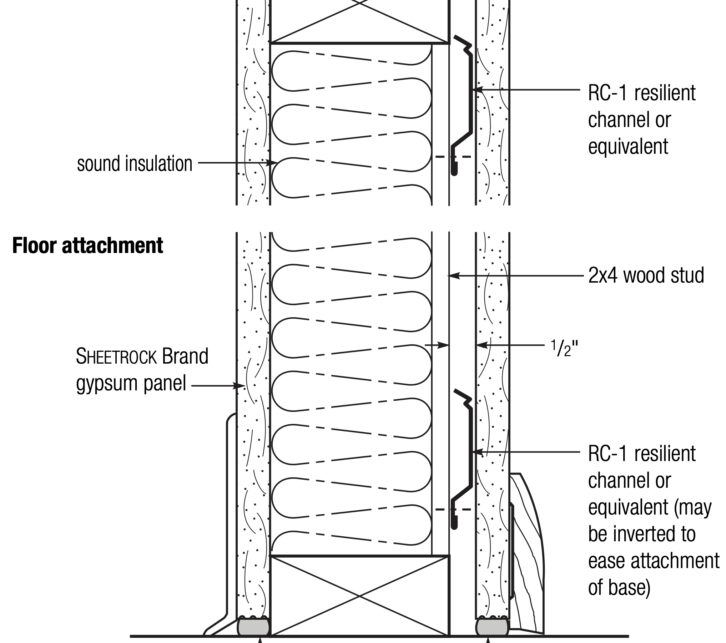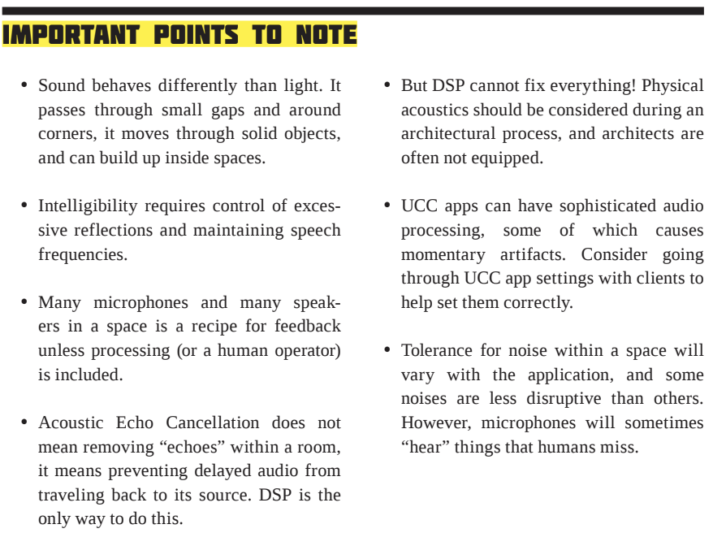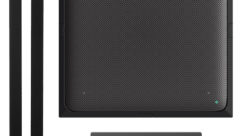
 I have a client with a large executive conference room. The table is around 40ft long and seats 40+ people, each of whom has a push-to-talk table mic. There are ceiling speakers in pairs above the table, about every 8ft. This system was installed years ago by someone who knew how to use the Biamp Tesira DSP to control the behavior of all those mics. It works well.
I have a client with a large executive conference room. The table is around 40ft long and seats 40+ people, each of whom has a push-to-talk table mic. There are ceiling speakers in pairs above the table, about every 8ft. This system was installed years ago by someone who knew how to use the Biamp Tesira DSP to control the behavior of all those mics. It works well.
Unfortunately, they started having an issue of mics cutting out randomly. Naturally, this seemed to happen most when the CEO was talking. While I was troubleshooting the system, which took some time, as intermittent problems often do, the question came from on high: Can’t we just replace this complicated DSP system with some simple amps and speakers?
Um, no. Not with 40 mics! There was a disconnect between the client’s expectations and their understanding of the real world. We’ve all been there at some point; Trying to translate the realities of physics, or any kind of technical constraint, into something client-friendly can be tough.
Feedback and Echo Cancellation
The owner of the conference room was unaware of a few basic issues, the most obvious of which is feedback. Put an open microphone near a speaker receiving that mic’s signal, turn up the gain, and we know what happens. So one thing the DSP does in that system is break the space into zones, and only sends mics to speakers in zones further away.
The amount of “voice lift” from the system is subtle; enough so everyone can hear each other, but not loud. That’s as it should be in this setting, and also helps prevent feedback if several mics are used at once in different parts of the room. All the mic inputs are gated, so even if the TALK button is on, the mic channel will not be open unless someone is speaking directly in front.
This system also has acoustic echo cancellation on all the mic inputs, which is a concept that can be hard to explain. This is particularly true now, when everyone is accustomed to UCC conferencing apps that take care of it automatically. The AEC is in there, and it works surprisingly well in the background, giving the false sense that nothing special is going on.
The underlying principle of AEC is to identify an audio source that is NOT supposed to get into a local microphone and remove it. If the audio from the far-end caller in a Zoom session is coming out of your speaker, it’s picked up by your microphone. But the processing knows that the far-end audio should not be sent back to the far-end, so it’s removed from your outgoing mix. Your voice, which originates locally, is left alone. This is a subtle concept to explain but is key to having open conversation between local and remote participants without everyone wearing headphones!
Another thing some UCC apps do is attempt to remove extraneous noise. This function is getting better all the time but can cause strange results when non-speech audio is being sent. Music, for example, may have components that the UCC app interprets as “noise” and tries to reduce. In fact, some apps now have a setting for when music is part of the mix.
Processing for AEC and noise reduction, whether by dedicated DSP or within a computer app, takes some time and effort. This is one reason audio may be momentarily garbled, delayed, or lost; the echo and noise removal algorithms are analyzing and compensating in real time. In most situations it’s a continuous process, since the conditions change as people move, audio sources come and go, etc.
As with so much technology today, the average user is blissfully unaware of what’s really going on “under the hood,” while A/V professionals try to explain why things aren’t as simple as they seem! QSC has an excellent paper on Acoustic Echo Cancellation. It highlights their own processing, but also explains the principles.
Controlling Sound Acoustically
DSP may be part of making room audio work, but the starting point is really the environment itself. When people use terms like “soundproofing” a room, to me that means stopping sound from moving between spaces, and it isn’t done with soft treatments on walls. To prevent sound transmission from one place to another you need barriers with mass (dense materials), rigidity (or intentional non-rigidity), and physical disconnection of the spaces. Look at a typical audio recording or radio studio: Thick walls, heavy doors with edge seals, and multi-layer windows. Keeping unwanted sound out (or in) is not easy.

When I walk a space with a client I listen to the environment and try to identify likely deficiencies. Typical office walls aren’t very substantial to begin with, and are even less effective if sound is traveling between spaces via HVAC ducts, which may be common to several rooms. Worse, if the space above a grid ceiling is a return-air plenum, the walls probably stop at the grid and there are ceiling tiles full of holes so air can flow up. The whole plenum is a pathway for sound! Fixing these issues can involve extending walls up to the slab, ducting returns, and other modifications. (Sound going over the walls can also be a privacy issue.)
Low frequencies can be more challenging because of their very long wavelengths, which tend to propagate in all directions and don’t “see” barriers the same way as high frequencies. We’ve all experienced hearing bass playing through walls, while the rest of the music is faint. Stopping those low frequencies takes mass and separation, and sometimes more sophisticated acoustical techniques.
Mass can be added to walls in various ways (such as drywall layers), but soft materials on the surface won’t do much to stop sound transmission. Interior treatment is really about how sound behaves inside the room. Without even considering sonic accuracy, as you might in a recording studio, good intelligibility means controlling reflections. Like a bullet ricocheting around, the high frequencies which make speech intelligible bounce off hard surfaces. When all those reflections reach the ear they muddle up the original, direct sound.
Because of their relatively short wavelengths, high frequencies are easily absorbed by soft materials. Going back to a typical office, walls and glass are the primary reflectors. These are offset by carpeting, the slight absorption of ceiling tiles, and the absorption of people. In fact, most office spaces are acceptable for purposes like meetings. Adding soft materials strategically (even couches and cloth wall hangings) can help when needed.
Plus, not all reflections are inherently bad. Diffusing sound, by causing it to disperse in random ways as it decays, gives rooms a sense of ambience that feels natural (and helps reinforce speech). Unless you’re doing acoustical testing, you would not want to work in a completely “dead” room, with all reflections absorbed. These are not comfortable spaces. Fortunately, items found in most real rooms (furniture, shelving, stuff) provide enough diffusion.
Then there are cases where acoustic needs may conflict with the creativity of architects, who, in my experience, don’t know much about acoustics. Curved walls, for example, can create problems by bouncing sound around in strange ways. Likewise, lots of windows, windows on opposing walls, hard floors and ceilings–really any room with extensive hard surfaces and nothing absorbent–is a recipe for trouble controlling sound. Early intervention at the design phase is critical, if it’s possible at all, because some things just can’t be fixed with DSP.
Along those lines, among very difficult spaces for speech intelligibility is a large church or cathedral. These buildings are designed to be grand and spacious and are typically nothing but hard surfaces. The reverberation that makes a choir or organ sound great is a real problem for intelligibility. Simply adding reinforcement to make speech louder also has the effect of adding more reflective energy to the space. On top of that, putting up traditional types of acoustic treatment is often frowned upon. It can take some clever thinking, and specialized products, to make the speech louder and more intelligible, and not hurt the feeling of the space. For example, sometimes using more speakers, at lower volume, will get the sound to people’s ears without generating a lot of extra reflective energy. Beamforming is also a potential tool for these kinds of spaces; get the sound to the listeners, keep it off the walls.
Noise
Why would someone want to put their TV studio or conference room next to an elevator shaft, a restroom, or an HVAC closet? They wouldn’t, but sometimes that’s how things go. The concepts above for stopping sound transmission apply to these situations, but low-frequency vibration and impact noise can get into spaces via unexpected routes. For example, vibration from an HVAC motor may travel along ductwork, requiring a flexible joint to decouple the parts of the duct. Transmission via building steel, wall studs, floor and ceiling joists, and other architectural components can bring noise into the audio space.
The same kind of transmission can happen with higher frequencies. In my own home we installed a hot water recirculating pump. It sits on top of the water heater, in the main hot water line. Sure enough, it caused a loud and distinctive hum in one bathroom. Adding a piece of flex pipe right at the pump decoupled it significantly (though I probably need a loop of flex to stop it completely).
Decoupling on a larger scale may be necessary. A second wall, separated by an air space, is a common technique for isolating a room from outside noise, but it requires attention to detail so that an errant piece of structure (like a stabilizing stud) doesn’t act as a bridge between the two walls and defeat the purpose. This is when we move from basic fixes to isolation techniques used in critical audio facilities, where “room within a room” construction is common.
As you move around a space, what else do you hear? It’s quite common to hear whistling or whooshing from air moving through ducts and registers. Maybe there’s something jiggling around causing tapping noises or rattles. VAV (variable air flow) boxes in ducts are great sources of occasional creaking and clattering. Often these things are within the space itself and can be fixed with minimal intervention.
On the other hand, I have a client with a TV studio next to a room of high-voltage switchgear. It’s normally quiet, but every so often there’s a surge of hum through the wall. That’s a tough one. A more common electrical noise is from lighting–usually the hum and buzz of fluorescent ballasts in older offices. Sometimes just turning off the lights makes a big difference, and these are easily replaced.
HVAC noise in general–blowing and hissing–may be tolerable if it’s not too loud. Continuous soft whooshing (ala “white noise”) is preferable to whistles and clanks, or to a system starting and stopping every few minutes. Using highly directional or less-sensitive mics, away from the noise source, might be helpful. These choices depend on the use of the room and tolerance of the users. But if the client can’t afford the necessary fixes, and opts to “turn the air conditioning off while we’re using the room,” I have found that this rarely goes well. You end up with hot, ornery people and general inconvenience every day. Sound concepts should be intrinsic to the built environment.











